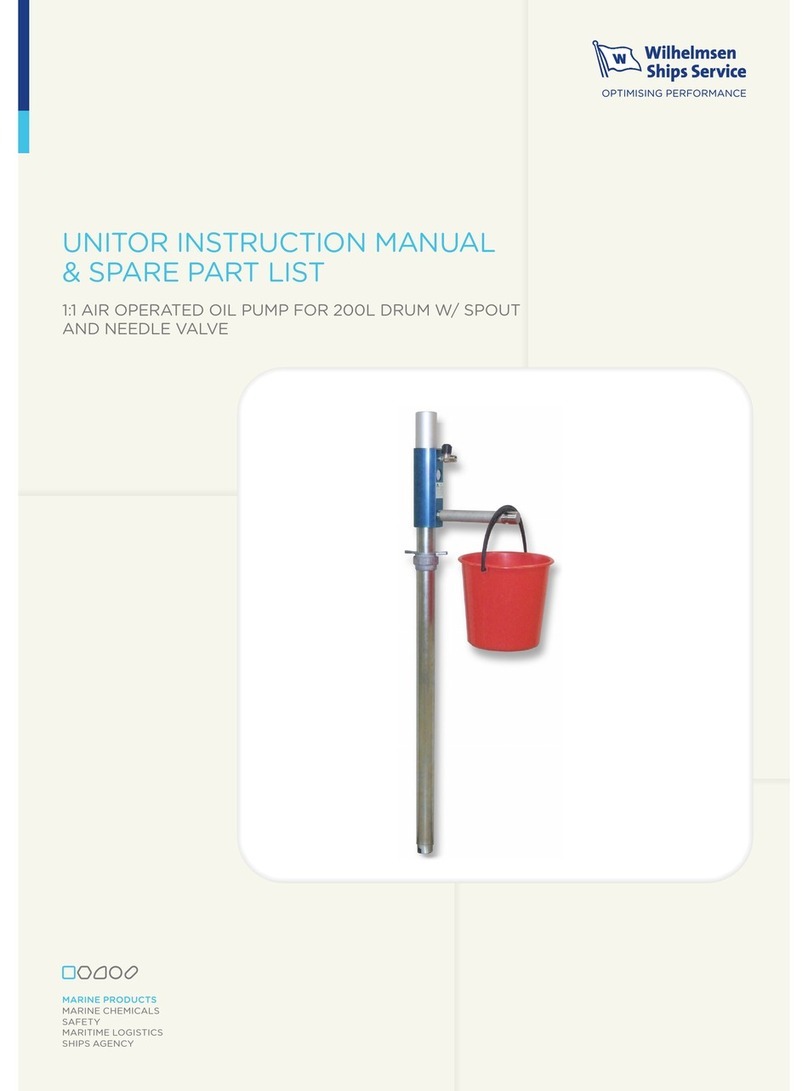
2
Thank you for choosing a high quality pump. These 1:1 pump models are designed to move a broad
spectrum of fluids, such as coolants, anti freeze, inks, glue and other chemicals who are compatible
with AISI 316, Viton and PTFE seals. The pump’s 2” bung adapter allows installation directly onto
original containers or bulk tanks.
1:1 CHEMICAL PUMP SST316 FOR 200L DRUM
(W/ HOSE & GUN) / (W/ OUTLET SPOUT)
INSTRUCTION MANUAL & SPARE PARTS LIST
GENERAL
• A pump’s ability to deliver fluid is based on the pressure (bar/
psi) and quantity of air supplied to the air- motor and the
amount of material discharge (back) pressure to be overcome
within the system.
• Warning! An explosion can result in the pump when aluminium
and zink parts come in contacts with certain solvents. Never
point a control valve at any portion of your body or another
person. Accidential discharge of pressure and/or material can
result in injury. Read these instruction carefully before installa-
tion, operation or service.
• DO NOT EXCEED MAXIUMUM PRESSURE
Installation/Operation
To achieve long pump life we recommend that filter regulator to
be installed prior to the air inlet of the pump.
Remove the protective packaging from the pump and also the
protective plugs.
Fit the 2” pump adaptor firmly on to the barrel.
Mount the pump into the pump adaptor and lock into position.
Fit and secure the outlet hose.
Fit and secure the air inlet hose, slowly increase the air pressure
letting the pump slowly build up fluid pressure.
Ensure there are no leaks either on the air inlet or at the fluid
outlet. To obtain maximum vacuum all connections should be
sealed and tight.
Slowly increase the air pressure to optimum working pressure.
Warning! The maximum permitted air pressure is 10bar, do not
exceed this limit. Service: Before any servicework is carried out
the compressed air must be turned off to the pump or the air
coupling disconnected. And the fluid outlet must be depressur-
ized completely.
Maintenance
Before any service work is carried out the compressed air must
be turned off to the pump or the air coupling disconnected. And
the fluid outlet must be depressurized completely.
Clean the air filter, remove all pollutants including condensed
water. Check system for any air or fluid leaks.
Always keep the equipment clean and remove foreign objects,
ensure no pollutants enter the barrel as these will be pumped into
the system.
When changing the barrel make sure the pump remains clean
(Do not put on to floor otherwise the fluid will become polluted).
Service
For your personal safety ensure the air is disconnected from the
pump, and the fluid discharge is depressurized before any ser-
vice is carried out. Be cautious when repressurizing the system
after any service work is carried out.
During service procedures it is important to avoid any scratching
or any other damage to gasket or bearings surfaces. Keep tools
and benches clean. Be extremely cautious when assembling or
dismantling V-packings and O-rings. Exchange all worn or dam-
aged parts no matter how slightly damaged they seem.
Clean and grease all gasket, bearing surfaces including O-rings
and gaskets with teflon grease when reassembling pump.
Try to use paraffin to clean pump parts. If water based cleaners
are used, wipe parts clean & dry immediately to avoid corrosion.
Product safety instructions
The pump is intended for non-corrosive and petroleum based
liquids. It may NOT be used for other purposes or for pumping
gasoline. Check all components thoroughly for damage and
leakage. Ensure that the compressed air is disconnected from
the pump and the system is depressurized when system is not in
use.
The pump is made up of two main parts: A compressed air
operated two way piston air motor and a double acting liquid
pump. The liquid is sucked into the pump tube via the bottom
valve. When the piston moves upwards liquid is forced out of the
fluid outlet. The fluid is forced out of the pump when the piston is
moving in both directions. The relationship between the air piston
and the pump piston determines the ratio of the pump. If the
pump ratio is 1:1 the theoretical fluid pressure will be 1 times to
the air pressure, when the pump stalls out. The air is exhausted
from the pump via a sound attenuator.
Technical data
Pump ratio 1:1
Maximum air presssure (bar) 10 bar
Maximum air presssure (psi) 150 psi
Delivery per minute (@ 7 bar air pressure, 0 backpressure) 30L/min
Air inlet connection 1/4” BSP
Fluid outlet 3/4” BSP
Pump tube length 930mm
Pump tube diameter Ø50mm
Total length 1240mm






















